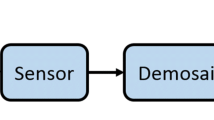Abstract
In recent decades, blind feature-based source camera detection has drawn a lot of attention. In literature, researchers used a specific sort of distortion, such as vignetting effects, chromatic aberration, and radial lens distortion, etc., to distinguish between different camera models. Therefore, it becomes specific to the distortions present in the particular camera model. However, distortion-specific approaches perform poorly in the absence of the specific distortion in an image. To develop a source camera identification system, we introduce a non-distortion-specific methodology using normalized DCT coefficients, a generalized Gaussian distribution (GGD) model-based blind features. DCT is performed on the sub-images of N × N blocks after the image is normalized using mean subtracted contrast normalization (MSCN). Over three scales, the DCT features are extracted. To perform camera model identification, a multi-class SVM is used to utilize all the extracted features. The experiment was conducted on the Dresden image database, which contains 10,173 images captured by 43 devices distributed over 12 camera models. The proposed method showed a maximum accuracy of 98.82% on the dataset.
Access this chapter
Tax calculation will be finalised at checkout
Purchases are for personal use only
Similar content being viewed by others
References
Verdoliva L (2016) Handbook of digital forensics of multimedia data and devices. IEEE Signal Process Mag 33(1):164–165
Piva A (2013) An overview on image forensics. ISRN Signal Process 2013:1–22
Friedman G (1993) The trustworthy digital camera: restoring credibility to the photographic image. IEEE Trans Consum Electron 39:905–910
Blythe P, Fridrich J (2004) Secure digital camera. In: Proceedings of the Digital Forensic Research Workshop (DFRWS ’04), pp 17–19
Cox I, Bloom J, Bloom J, Miller M (2001) Digital watermarking. Morgan Kaufmann
Cox I, Miller M, Bloom J, Fridrich J, Kalker T (2008) Digital Water-Marking and Steganography, 2nd edn. Morgan Kaufmann
Farid H (2009) Image forgery detection. IEEE Signal Process Mag 26:16–25
Mahdian B, Saic S (2010) A bibliography on blind methods for identifying image forgery. Signal Process: Image Commun 25:389–399
Le N, Retraint F (2019) An improved algorithm for digital image authentication and forgery localization using demosaicing artifacts. IEEE Access 7:125038–125053
Chen C, Stamm M (2015) Camera model identification framework using an ensemble of demosaicing features. In: 2015 IEEE international workshop on information forensics and security (WIFS)
Zhao X, Stamm M (2016) Computationally efficient demosaicing filter estimation for forensic camera model identification. In: 2016 IEEE international conference on image processing (ICIP)
Marra F, Poggi G, Sansone C, Verdoliva L (2016) A study of co-occurrence based local features for camera model identification. Multimed Tools Appl 76:4765–4781
Bayar B, Stamm M (2017) Design principles of convolutional neural networks for multimedia forensics. Electron Imag 29:77–86
Chen M, Fridrich JJ, GoljanM LJ (2008) Determining image origin and integrity using sensor noise. IEEE Trans Inf Forensics Secur 3(1):74–90
Tuama A, Comby F, Chaumont M (2016) Camera model identification with the use of deep convolutional neural networks. In: 2016 IEEE International Workshop on Information Forensics and Security (WIFS)
Freire-Obregón D, Narducci F, Barra S, Castrillón-Santana M (2019) Deep learning for source camera identification on mobile devices. Pattern Recogn Lett 126:86–91
Chen Y, Huang Y, Ding X (2017) Camera model identification with residual neural network. In: 2017 IEEE International Conference on Image Processing (ICIP)
Mandelli, S., Bonettini, N. and Bestagini, P. Source camera model identification. Multimedia Forensics, pp 133–173(2022)
Dirik AE, SencarHT MND (2008) Digital single lens reflex camera identification from traces of sensor dust. IEEE Trans Inf Forensics Secur 3(3):539–552
Lukás J, Fridrich JJ, Goljan M (2006) Digital camera identification from sensor pattern noise. IEEE Trans Inf Forensics Secur 1(2):205–214
Thai TH, Cogranne R, Retraint F (2014) Camera model identification based on the heteroscedastic noise model. IEEE Trans Image Proc 23(1):250–263
Thai TH, Retraint F, Cogranne R (2016) Camera model identification based on the generalized noise model in natural images. Dig Signal Proc 48:285–297
Galdran A, Araújo T, Mendonça A, Campilho A (2017) Retinal image quality assessment by mean-subtracted contrast-normalized coefficients. VipIMAGE 2017:844–853
Mittal A, Moorthy A, Bovik A (2012) No-reference image quality assessment in the spatial domain. IEEE Trans Image Process 21:4695–4708
Saad M, Bovik A, Charrier C (2012) Blind image quality assessment: a natural scene statistics approach in the DCT domain. IEEE Trans Image Process 21:3339–3352
Sharifi K, Leon-Garcia A (1995) Estimation of shape parameter for generalized Gaussian distributions in subband decompositions of video. IEEE Trans Circuits Syst Video Technol 5:52–56
Gloe T, Böhme R (2010) The Dresden image database for benchmarking digital image forensics. J Dig Forens Pract 3:150–159
Chang C, Lin C (2011) LIBSVM. ACM Trans Intell Syst Technol 2:1–27
Bondi L, Baroffio L, Guera D, Bestagini P, Delp E, Tubaro S (2017) First steps toward camera model identification with convolutional neural networks. IEEE Signal Process Lett 24:259–263
Wang B, Yin J, Tan S, Li Y, Li M (2018) Source camera model identification based on convolutional neural networks with local binary patterns coding. Signal Process Image Commun 68:162–168
Yao H, Qiao T, Xu M, Zheng N (2018) Robust multi-classifier for camera model identification based on convolution neural network. IEEE Access 6:24973–24982
Ferreira W, Ferreira C, da Cruz Júnior G, Soares F (2020) A review of digital image forensics. Comput Electr Eng 85:106685
Author information
Authors and Affiliations
Corresponding author
Editor information
Editors and Affiliations
Rights and permissions
Copyright information
© 2023 The Author(s), under exclusive license to Springer Nature Singapore Pte Ltd.
About this paper
Cite this paper
Roy, P., Mitra, S., Das, N. (2023). Source Camera Identification Using GGD and Normalized DCT Model-Based Feature Extraction. In: Das, N., Binong, J., Krejcar, O., Bhattacharjee, D. (eds) Proceedings of International Conference on Data, Electronics and Computing. ICDEC 2022. Algorithms for Intelligent Systems. Springer, Singapore. https://doi.org/10.1007/978-981-99-1509-5_27
Download citation
DOI: https://doi.org/10.1007/978-981-99-1509-5_27
Published:
Publisher Name: Springer, Singapore
Print ISBN: 978-981-99-1508-8
Online ISBN: 978-981-99-1509-5
eBook Packages: Intelligent Technologies and RoboticsIntelligent Technologies and Robotics (R0)




